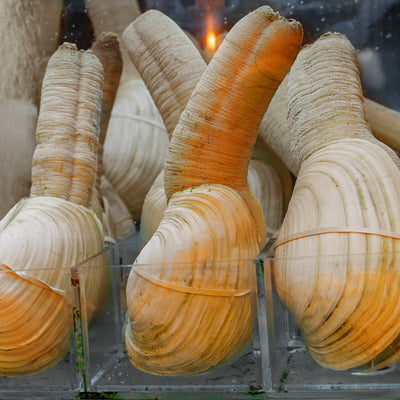Geoduck: Nature’s Gift – A Unique Delicacy from the Pacific Northwest

Geoduck: Nature’s Gift and a Culinary Delicacy
Among the many wonders of the ocean, the geoduck (pronounced "gooey-duck") stands out as one of the most fascinating and unique clams. Known for its remarkable size, long lifespan, and exquisite taste, this burrowing bivalve has gained recognition in both seafood cuisine and cultural traditions.
Native to the Pacific Northwest, geoducks are not just a delicacy but also a symbol of sustainable aquaculture. In this article, we’ll explore:
✔ What makes geoducks unique
✔ Where they are found and how they are farmed
✔ Their culinary appeal and cultural significance
✔ Sustainability and conservation efforts
Whether you’re a seafood enthusiast or simply curious about this unusual clam, read on to discover why the geoduck is truly nature’s gift!
What is a Geoduck?
🔹 A Clam Unlike Any Other
The geoduck (Panopea generosa) is the world’s largest burrowing clam, with its siphon (neck) growing up to 3 feet long. Unlike typical clams, its shell is small relative to its body, and it cannot fully close due to its enormous siphon.
🔹 Where Do Geoducks Live?
✔ Native to the Pacific Northwest – Found along the coastlines of Washington, British Columbia, and Alaska.
✔ Buried Deep in the Sand – Geoducks live up to 3 feet underground, using their siphon to filter-feed plankton.
✔ A Long-Lived Species – The oldest geoducks can live over 150 years, making them one of the longest-living marine species.
🔹 Fun Fact: The oldest recorded geoduck lived 168 years!
Geoduck Farming & Sustainability
Due to high demand in seafood markets, especially in China, Japan, and the U.S., geoduck farming has become an important industry.
🔹 How Geoducks Are Farmed
✔ Aquaculture in the Pacific Northwest – Young geoducks are grown in protected underwater farms before being harvested.
✔ Takes 5–7 Years to Mature – Unlike other seafood, geoducks require patience and careful management.
✔ Sustainable Harvesting – Farmers ensure environmental balance by monitoring water quality, stocking density, and seafloor health.
🔹 Why Sustainable Farming Matters
✔ Prevents Overharvesting – Wild geoduck populations are protected through strict fishing regulations.
✔ Reduces Environmental Impact – Farmed geoducks enhance marine ecosystems by filtering water and removing excess nutrients.
✔ Supports Local Economies – Geoduck farming provides jobs and boosts coastal communities.
🔹 Pro Tip: When buying geoduck, look for certified sustainable sources to support responsible seafood practices.
Culinary Uses: How to Enjoy Geoduck
The geoduck’s sweet, briny, and crisp texture makes it highly sought after by chefs.
🔹 What Does Geoduck Taste Like?
✔ Mildly sweet, slightly salty – A balance between clams and oysters.
✔ Crisp yet tender – The siphon is crunchy, while the body is softer.
✔ Perfect for raw or cooked dishes – Used in sushi, stir-fries, and soups.
🔹 Best Ways to Eat Geoduck
| Dish | How It’s Used | Flavor & Texture |
|---|---|---|
| Sashimi (Raw) | Thinly sliced and served with soy sauce & wasabi | Sweet, briny, crisp |
| Stir-Fry | Sautéed with vegetables and sauces | Tender, absorbs flavors |
| Chowder | Used in seafood soups | Adds richness and depth |
| Hot Pot | Thin slices cooked briefly in broth | Soft, slightly chewy |
| Grilled or Seared | Lightly charred over high heat | Smoky, caramelized taste |
🔹 Pro Tip: To keep geoduck tender and flavorful, avoid overcooking—quick cooking methods work best!
Cultural Significance of Geoduck
🔹 Indigenous Traditions
For Pacific Northwest Indigenous tribes, geoducks hold great cultural value:
✔ A traditional food source – Harvested for centuries in tribal feasts and ceremonies.
✔ Symbol of longevity – Their long lifespan represents strength and resilience.
🔹 Geoduck in Asian Cuisine
✔ China & Japan: Considered a luxury delicacy, often served as sashimi or in hot pots.
✔ South Korea: Used in spicy seafood stir-fries.
✔ Vietnam: Popular in steamed seafood dishes.
🔹 Pro Tip: High-quality geoducks are exported globally, with live specimens fetching premium prices!
Where to Buy Geoduck
Looking to try fresh, premium geoduck? Order from trusted seafood suppliers specializing in sustainably sourced clams.
👉 Buy Fresh Geoduck – Sustainably Sourced & Live
👉 Explore Live & Sustainable Seafood Options
👉 Shop for Fresh Clams, Mussels & More
👉 Try Unique Seafood Like Gooseneck Barnacles
📺 Watch Geoduck Preparation & Tasting on YouTube: @GlobalSeafoods
Final Thoughts: Why Geoduck is Nature’s Gift
✔ Unique in size, lifespan, and taste
✔ A delicacy in high-end seafood cuisine
✔ Supports sustainable aquaculture and local economies
✔ Rich in cultural history and traditions
The geoduck is more than just a giant clam—it’s a testament to the wonders of marine life. Whether you’re a seafood connoisseur or a first-time taster, experiencing fresh geoduck is an adventure in both taste and tradition.
🌊 Ready to try this seafood treasure? Order fresh geoduck today!
Also in News

How to Make Sea Bream Sushi With Dry-Aged Tuna & Crab Roll — Step-by-Step With Chef Joshua
A complete guide to making Sea Bream sushi at home, including filleting, curing, slicing, and building a Dry-Aged Tuna & Crab sushi roll. Chef Joshua shares professional tips for restaurant-quality results.

Boiled Crab for Game Night: Everything You Need for a Perfect Seafood Party
Take your game night to the next level with a Boiled crab party. Learn the best recipes, cooking tips, and hosting hacks for a memorable seafood feast.

Boiled Crab for Date Night: A Romantic Guide to the Perfect Seafood Feast
Make your next date night unforgettable with a romantic Boiled crab experience. This guide covers everything you need to know, from ambiance to the best crab varieties.

